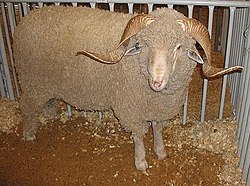

|
No edit summary
|
m Reverted 2 edits by 2406:E000:600A:1:8003:6C8F:9621:EAEC identified as test/vandalism using STiki
|
||
| Line 1: | Line 1: | ||
[[Image:Rambouillet.jpg|thumb|250px|Rambouillet ram.]] |
[[Image:Rambouillet.jpg|thumb|250px|Rambouillet ram.]] |
||
The '''Rambouillet''' is a breed of [[sheep]] also known as the Rambouillet [[Merino]] or the French Merino. The development of the Rambouillet breed started in 1786, when [[Louis XVI of France|Louis XVI]] purchased over 300 |
The '''Rambouillet''' is a breed of [[sheep]] also known as the Rambouillet [[Merino]] or the French Merino. The development of the Rambouillet breed started in 1786, when [[Louis XVI of France|Louis XVI]] purchased over 300 Spanish Merinos (318 ewes, 41 rams, 7 wethers) from his cousin, King [[Charles III of Spain]]. The flock was subsequently developed on an experimental royal farm, the ''Bergerie royale'' (now ''Bergerie nationale'') owned by Louis XVI, and built on his Domain of Rambouillet, 50 km southwest of Paris. The flock was raised exclusively at the ''Bergerie'', with no sheep being sold for many years.<ref name="Stewart"> |
||
{{cite web |
{{cite web |
||
|url=http://www.tumbledownfarm.com/texts/DS/DS_II.html |
|url=http://www.tumbledownfarm.com/texts/DS/DS_II.html |
||

The Rambouillet is a breed of sheep also known as the Rambouillet Merino or the French Merino. The development of the Rambouillet breed started in 1786, when Louis XVI purchased over 300 Spanish Merinos (318 ewes, 41 rams, 7 wethers) from his cousin, King Charles III of Spain. The flock was subsequently developed on an experimental royal farm, the Bergerie royale (now Bergerie nationale) owned by Louis XVI, and built on his Domain of Rambouillet, 50 km southwest of Paris. The flock was raised exclusively at the Bergerie, with no sheep being sold for many years.[1]
Outcrossing with English long-wool breeds and selection produced a well-defined breed,[2] differing in several important points from the original Spanish Merino. The size was greater, with full-grown ewes weighing up to 200 pounds and rams up to 300 pounds, live weight. The wool clips were larger and the wool length had increased to greater than three inches.
In 1889, the Rambouillet Association was formed in the United States with the aim of preserving the breed.[3] An estimated 50% of the sheep on the US western ranges are of Rambouillet blood.[4] Rambouillet stud has also had an enormous influence on the development of the Australian Merino industry though Emperor and the Peppin Merino stud.
The fleece was valuable in the manufacture of cloth, at times being woven in a mixed fabric of cotton warp and wool weft, known as delaine.[5][6]
The breed is well known for its wool, but also for its meat, both lamb and mutton. It has been described as a dual-purpose breed, with superior wool and near-mutton breed characteristics.